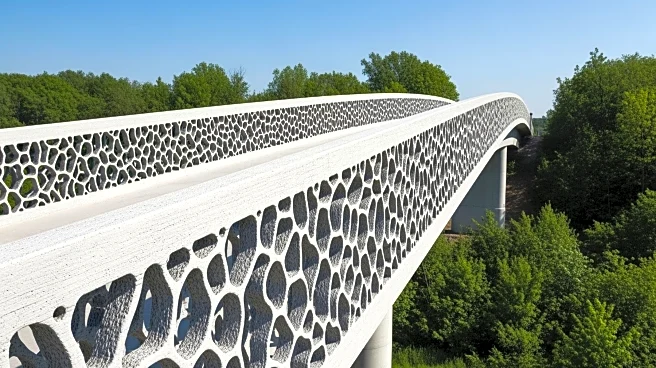What's Happening?
A research team at the University of Pennsylvania has developed a 3D-printed concrete bridge that absorbs carbon dioxide, inspired by the structure of bones. The project, named Diamanti, utilizes a robotic
3D printer to create complex lattice-like patterns with a sustainable concrete mixture. This innovative design absorbs 142% more carbon dioxide than conventional concrete mixes and uses 60% less material while maintaining mechanical strength. The bridge prototype, currently on display in Venice, is modular and printed in blocks connected on-site with tension cables. The project was launched in collaboration with Swiss chemical company Sika and supported by grants from the US Department of Energy.
Why It's Important?
Concrete is the most used manmade material globally, but it has a significant carbon footprint, contributing to around 8% of global greenhouse emissions. The Diamanti project represents a major advancement in reducing the environmental impact of concrete by enhancing its carbon absorption capabilities. This development could lead to more sustainable construction practices and help the cement industry reduce its emissions, which have increased due to rising demand. The innovative approach of combining material-saving design with novel materials offers potential solutions for the construction sector to manage material demands and reduce carbon emissions.
What's Next?
The Diamanti team is preparing to build its first full-size prototype in France, with the location still being decided. The project has secured approval for construction, and the team is eager to test their designs in real-world conditions. Beyond bridges, the team is exploring other architectural applications, such as prefabricated floor systems. The success of these initiatives could pave the way for broader adoption of sustainable concrete mixtures and innovative design techniques in the construction industry.
Beyond the Headlines
The use of diatomaceous earth in the concrete mixture presents supply chain considerations for future wider adoption. While the material has potential, its availability must be assessed to meet the high demands for concrete. The increased surface area of the bridge enhances carbon absorption, providing a two-pronged approach that could be used together or separately. This project highlights the importance of exploring multiple solutions to address the environmental impact of construction materials.












